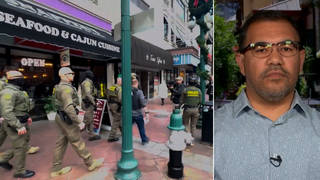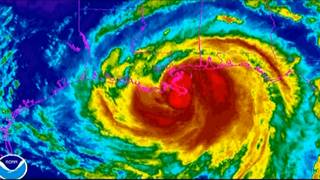
We go back to the spring of 1927 when the Mississippi River flooded after weeks of incessant rains. While the federal government response was well-coordinated, African Americans were rounded into work camps by land owners and prevented from leaving as the waters rose. [includes rush transcript]
While the survivors of Hurricane Katrina struggle to cope the devastation, this is not the first time the Gulf Coast has been wracked by a natural disaster.
In the spring of 1927, after weeks of incessant rains, the Mississippi River flooded. Racing south from Cairo, Illinois, the river blew away levee after levee, inundating thousands of farms and hundreds of towns, killing as many as a thousand people and leaving nearly a million homeless. The disaster laid bare the feudal between whites and blacks in the South.
As New York Times columnist David Brooks writes, “Blacks were rounded up into work camps and held by armed guards. They were prevented from leaving as the waters rose. A steamer, the Capitol, played “Bye Bye Blackbird” as it sailed away.” The racist violence that followed the floods helped persuade many blacks to move north.”
- Pete Daniel, author, “Deep’N As It Come: The 1927 Mississippi River Flood.” He is curator in the Division of Work and Industry at the National Museum of American History.
Transcript
AMY GOODMAN: We’re joined now in Washington, D.C., by Pete Daniel, author of, “Deep’N as it Come: The 1927 Mississippi River Flood.” He’s the curator of the Division of Work and Industry at the National Museum of American History. We welcome you to Democracynow! We only have — its great to have you with us, but we only have a few minute, but if you could describe what happened in 1927, the natural disaster and then the man-made disaster that followed?
PETE DANIEL: Well, it was a wet spring, to put it briefly, and the Mississippi river, which draws water from so much of the country flooded. And the levee system failed, all down the river, and something close to a million people were out of their homes. 300,000 of them were fed in 154 Red Cross camps. Others lived with relatives. You see the same thing developing today. Of course in 1927, the South had segregation, and although during the rescue aspect, people were taken as they came, black and white. Once they were in camps, they were segregated, and of course, African-Americans received inferior bedding, tents and so forth. So, it was a major disaster in some cases, it would last a week and then the water would go down and people could return, and in other cases it would be months before people could return to their farms. And as you mentioned, there was a major crisis in the camps because people were not free to leave. And there were other problems also, but I have to say that the coordination of the relief in 1927, under Herbert Hoover, who was Secretary of Commerce, was really well run. They had all kinds of different agencies involved from the Red Cross to the War Department at that time, and people were rescued quickly. They were put in camps, and they were cared for. In some cases they had a better life in the camps than they had the plantations they came from.
AMY GOODMAN: Well, Pete Daniel, I want to thank you very much for being with us. Author of “Deep’N as it Come: The 1927 Mississippi River flood.” Curator of the Division of Work and Industry at the National Museum of American History.












Media Options